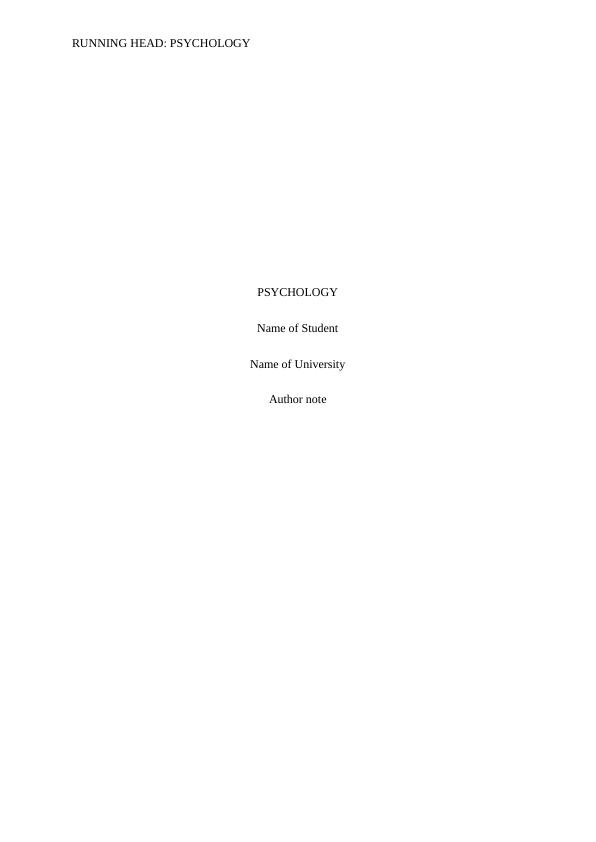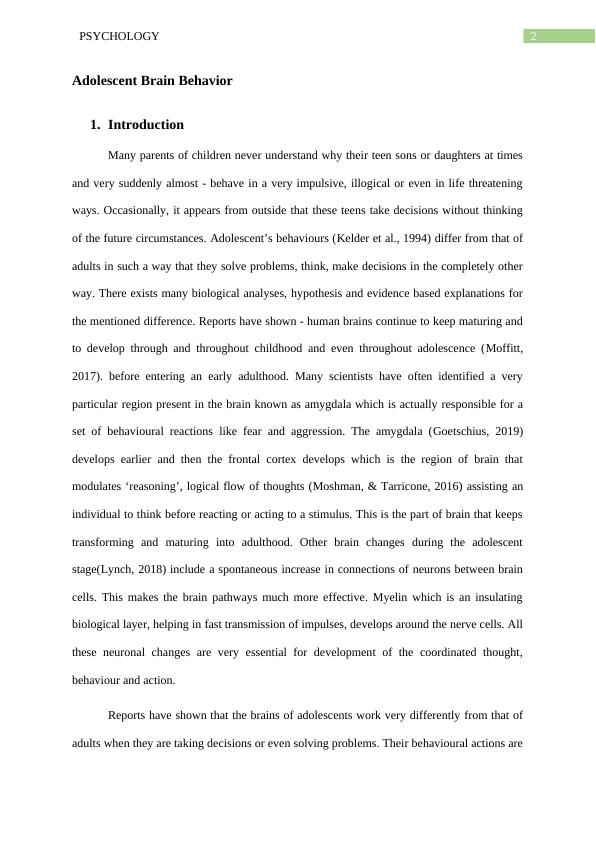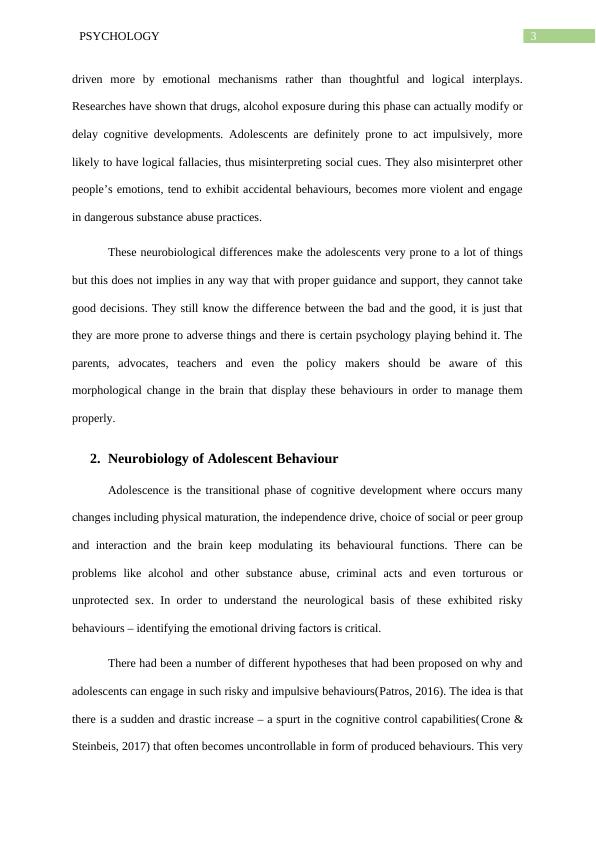Neurobiology of Adolescent Behavior
Added on 2023-03-17
12 Pages3371 Words61 Views
RUNNING HEAD: PSYCHOLOGY
PSYCHOLOGY
Name of Student
Name of University
Author note
PSYCHOLOGY
Name of Student
Name of University
Author note

1PSYCHOLOGY
Table of Contents
Adolescent Brain Behavior........................................................................................................2
1. Introduction.........................................................................................................................2
2. Neurobiology of Adolescent Behaviour.............................................................................3
3. The Neurobiological Control..............................................................................................4
4. Self-regulation in adolescent behavior...............................................................................5
5. Concepts in Adolescent brain behavior:.............................................................................6
Concept 1: Neuro-circuitry and Neuronal plasticity helps in adolescent brain modeling.....6
Application of Concept 1 in Education settings.....................................................................6
Concept 2: Neuro-behavior of adolescents as a ‘Sensation seeking’ behavior......................7
Application of Concept 2 in Education settings.....................................................................7
Concept 3: Trajectories of adolescent neurodevelopment of neuronal circuitry important
for decision computations......................................................................................................8
Application of Concept 3 in an Educational setting...............................................................9
Table of Contents
Adolescent Brain Behavior........................................................................................................2
1. Introduction.........................................................................................................................2
2. Neurobiology of Adolescent Behaviour.............................................................................3
3. The Neurobiological Control..............................................................................................4
4. Self-regulation in adolescent behavior...............................................................................5
5. Concepts in Adolescent brain behavior:.............................................................................6
Concept 1: Neuro-circuitry and Neuronal plasticity helps in adolescent brain modeling.....6
Application of Concept 1 in Education settings.....................................................................6
Concept 2: Neuro-behavior of adolescents as a ‘Sensation seeking’ behavior......................7
Application of Concept 2 in Education settings.....................................................................7
Concept 3: Trajectories of adolescent neurodevelopment of neuronal circuitry important
for decision computations......................................................................................................8
Application of Concept 3 in an Educational setting...............................................................9

2PSYCHOLOGY
Adolescent Brain Behavior
1. Introduction
Many parents of children never understand why their teen sons or daughters at times
and very suddenly almost - behave in a very impulsive, illogical or even in life threatening
ways. Occasionally, it appears from outside that these teens take decisions without thinking
of the future circumstances. Adolescent’s behaviours (Kelder et al., 1994) differ from that of
adults in such a way that they solve problems, think, make decisions in the completely other
way. There exists many biological analyses, hypothesis and evidence based explanations for
the mentioned difference. Reports have shown - human brains continue to keep maturing and
to develop through and throughout childhood and even throughout adolescence (Moffitt,
2017). before entering an early adulthood. Many scientists have often identified a very
particular region present in the brain known as amygdala which is actually responsible for a
set of behavioural reactions like fear and aggression. The amygdala (Goetschius, 2019)
develops earlier and then the frontal cortex develops which is the region of brain that
modulates ‘reasoning’, logical flow of thoughts (Moshman, & Tarricone, 2016) assisting an
individual to think before reacting or acting to a stimulus. This is the part of brain that keeps
transforming and maturing into adulthood. Other brain changes during the adolescent
stage(Lynch, 2018) include a spontaneous increase in connections of neurons between brain
cells. This makes the brain pathways much more effective. Myelin which is an insulating
biological layer, helping in fast transmission of impulses, develops around the nerve cells. All
these neuronal changes are very essential for development of the coordinated thought,
behaviour and action.
Reports have shown that the brains of adolescents work very differently from that of
adults when they are taking decisions or even solving problems. Their behavioural actions are
Adolescent Brain Behavior
1. Introduction
Many parents of children never understand why their teen sons or daughters at times
and very suddenly almost - behave in a very impulsive, illogical or even in life threatening
ways. Occasionally, it appears from outside that these teens take decisions without thinking
of the future circumstances. Adolescent’s behaviours (Kelder et al., 1994) differ from that of
adults in such a way that they solve problems, think, make decisions in the completely other
way. There exists many biological analyses, hypothesis and evidence based explanations for
the mentioned difference. Reports have shown - human brains continue to keep maturing and
to develop through and throughout childhood and even throughout adolescence (Moffitt,
2017). before entering an early adulthood. Many scientists have often identified a very
particular region present in the brain known as amygdala which is actually responsible for a
set of behavioural reactions like fear and aggression. The amygdala (Goetschius, 2019)
develops earlier and then the frontal cortex develops which is the region of brain that
modulates ‘reasoning’, logical flow of thoughts (Moshman, & Tarricone, 2016) assisting an
individual to think before reacting or acting to a stimulus. This is the part of brain that keeps
transforming and maturing into adulthood. Other brain changes during the adolescent
stage(Lynch, 2018) include a spontaneous increase in connections of neurons between brain
cells. This makes the brain pathways much more effective. Myelin which is an insulating
biological layer, helping in fast transmission of impulses, develops around the nerve cells. All
these neuronal changes are very essential for development of the coordinated thought,
behaviour and action.
Reports have shown that the brains of adolescents work very differently from that of
adults when they are taking decisions or even solving problems. Their behavioural actions are

3PSYCHOLOGY
driven more by emotional mechanisms rather than thoughtful and logical interplays.
Researches have shown that drugs, alcohol exposure during this phase can actually modify or
delay cognitive developments. Adolescents are definitely prone to act impulsively, more
likely to have logical fallacies, thus misinterpreting social cues. They also misinterpret other
people’s emotions, tend to exhibit accidental behaviours, becomes more violent and engage
in dangerous substance abuse practices.
These neurobiological differences make the adolescents very prone to a lot of things
but this does not implies in any way that with proper guidance and support, they cannot take
good decisions. They still know the difference between the bad and the good, it is just that
they are more prone to adverse things and there is certain psychology playing behind it. The
parents, advocates, teachers and even the policy makers should be aware of this
morphological change in the brain that display these behaviours in order to manage them
properly.
2. Neurobiology of Adolescent Behaviour
Adolescence is the transitional phase of cognitive development where occurs many
changes including physical maturation, the independence drive, choice of social or peer group
and interaction and the brain keep modulating its behavioural functions. There can be
problems like alcohol and other substance abuse, criminal acts and even torturous or
unprotected sex. In order to understand the neurological basis of these exhibited risky
behaviours – identifying the emotional driving factors is critical.
There had been a number of different hypotheses that had been proposed on why and
adolescents can engage in such risky and impulsive behaviours(Patros, 2016). The idea is that
there is a sudden and drastic increase – a spurt in the cognitive control capabilities( Crone &
Steinbeis, 2017) that often becomes uncontrollable in form of produced behaviours. This very
driven more by emotional mechanisms rather than thoughtful and logical interplays.
Researches have shown that drugs, alcohol exposure during this phase can actually modify or
delay cognitive developments. Adolescents are definitely prone to act impulsively, more
likely to have logical fallacies, thus misinterpreting social cues. They also misinterpret other
people’s emotions, tend to exhibit accidental behaviours, becomes more violent and engage
in dangerous substance abuse practices.
These neurobiological differences make the adolescents very prone to a lot of things
but this does not implies in any way that with proper guidance and support, they cannot take
good decisions. They still know the difference between the bad and the good, it is just that
they are more prone to adverse things and there is certain psychology playing behind it. The
parents, advocates, teachers and even the policy makers should be aware of this
morphological change in the brain that display these behaviours in order to manage them
properly.
2. Neurobiology of Adolescent Behaviour
Adolescence is the transitional phase of cognitive development where occurs many
changes including physical maturation, the independence drive, choice of social or peer group
and interaction and the brain keep modulating its behavioural functions. There can be
problems like alcohol and other substance abuse, criminal acts and even torturous or
unprotected sex. In order to understand the neurological basis of these exhibited risky
behaviours – identifying the emotional driving factors is critical.
There had been a number of different hypotheses that had been proposed on why and
adolescents can engage in such risky and impulsive behaviours(Patros, 2016). The idea is that
there is a sudden and drastic increase – a spurt in the cognitive control capabilities( Crone &
Steinbeis, 2017) that often becomes uncontrollable in form of produced behaviours. This very

End of preview
Want to access all the pages? Upload your documents or become a member.
Related Documents
Why Adolescent Children may be Less Logical and more Emotional in their Decision-Makinglg...
|6
|1098
|143
Neurology and Social Psychology | Assignmentlg...
|5
|2425
|329
Psychological Theory of Lifespan Developmentlg...
|2
|704
|43
